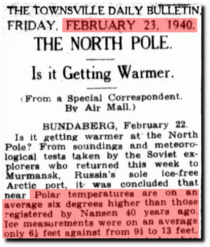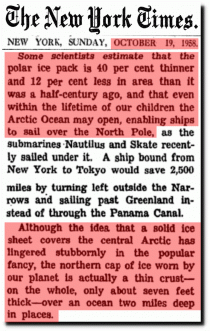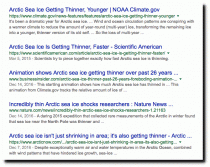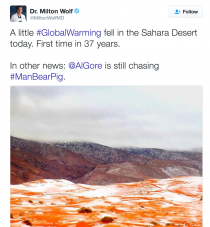By Tony Heller
The Danish Meteorological Institute reports that Arctic sea ice is about two meters thick.
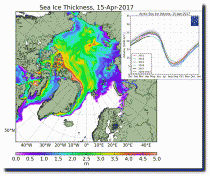
Enlarged
DMI Modelled ice thickness
In 1940, Arctic sea ice was also about two meters thick.
In 1958, the New York Times reported that Arctic ice was about two meters thick, and that people carry a popular misconception that the ice is much thicker than it is. They also predicted an ice-free Arctic within one generation.
The Changing Face of the Arctic; The Changing Face of the Arctic - The New York Times
Arctic sea ice is about the same thickness as 75 years ago, but because people are constantly being lied to about climate by government scientists, they carry the same misconceptions which people had 60 years ago.
By James Barrante
Recently, I stumbled upon a website called “Climate Kids.” It appears to be a website under the auspices of NASA. Normally, websites like these do not get my attention, except when they are specifically designed to teach science to our children. This is because children tend to believe their teachers know what they are talking about. The topic covered in that particular article was ocean “acidification.” Unfortunately, most of it was not correct. It looked like the person(s) writing this material never took a chemistry course above what we call “kiddie chem.”
The material covered began by trying to convince the reader that adding carbon dioxide to water always acidifies it. While this is true for “fresh” water - bodies of fresh water can be slightly acidic, having a pH below 7, because of dissolved carbon dioxide - this definitely is not true of seawater. Seawater contains high concentrations of salts. And while most people believe the salt in seawater is table salt (sodium chloride), seawater also contains high concentrations of salts known as carbonates and bicarbonates, which are antacids, causing seawater to be alkaline (basic: pH above 7), not acidic. The antacid Alka-Seltzer essentially is sodium bicarbonate.
When CO2 dissolves in seawater, it forms carbonic acid, classified chemically as a weak acid. However, bicarbonates and carbonates are salts of this weak acid, and when a weak acid is combined with one of its salts, it forms what is known as a buffer system. Buffer systems hold the pH (the level of acidity or alkalinity) constant. Our oceans are giant buffer systems, buffered to a pH of about 8.2. The actual pH of any buffer system depends on the ratio of the concentrations of weak acid or weak base to their salts.
Curiously, the CO2-bicarbonate buffer system is the exact same buffer system that maintains the pH of the blood in humans to a constant value of pH 7.4. Our blood is slightly less alkaline (approaching a neutral pH 7) than is seawater because the concentration of dissolved CO2 in blood is about 130 times greater than it is in seawater. To actually acidify seawater (i.e., drop its pH to below 7) with CO2, the level of CO2 in the atmosphere would have to increase to about 70,000 parts per million by volume (ppmv), compared with the present 400 ppmv.
I should point out to those who feel compelled to nitpick, these numbers are approximate, because pH depends on temperature and other properties of solutions. For example, blood temperature is about 37 degrees C; seawater temperature varies from about 2 degrees C at the poles to about 30 degrees C at the equator. The boundary between acid-base (neutrality) is pH 7 only at 25-degrees C.
Moreover, contrary to popular belief, if a solution is less alkaline, it is not more acidic. It is not like “hot and cold,” which are relative to the surroundings. A substance can be hot and cold at the same time. But, by definition, a solution cannot be acidic and alkaline at the same time. At 25 degrees C, a solution is acidic, if its pH is below 7, and alkaline, if its pH is above 7. To suggest a solution with a pH of 8.1 is more acidic than one with a pH of 8.4 totally misrepresents the concept of acid and base.
James Barrante of Cheshire is a retired college professor of physical chemistry.
by Willis Eschenbach
--------
Bill Nye the not-really-Science Guy was on Tucker Carlson tonight. Tucker tried time after time to get Nye to say how much of the change was due to humans ...and time after time, Nye refused to say what his opinion was.
So Tucker got him to agree that the climate has always been changing.
Then, in response to the question as to “what the climate would be like if humans weren’t involved right now”, Bill Nye said (according to my own transcription):
NYE: “The climate would be like it was in 1750. And the economics would be that you could not grow wine-worthy grapes in Britain as you can today because the climate is changing. The use of pesticides in the Midwest would not be increasing because the pests are showing up sooner and staying around longer. The forests in Wyoming would not be overwhelmed by pine bark beetles as it is because of climate change. That’s how the world would be different if it were not for humans”.
Oh, my goodness. Isn’t that touching? Nye refuses to say how much of the change in temperature is due to humans ... but at the same time he claims that if there weren’t humans, that the climate would have stopped changing in 1750. Without humans, he says, we would have a climate which was forever the same…
...and people actually believe this guy? Tucker Carlson was scathing:
CARLSON: You’re not even a scientist, you’re an engineer ... So much of this you don’t know, you pretend that you know, and you gotta believe people who ask you questions.
Another escapade in the world of pseudo-science. Anyhow, after writing this I found a YouTube video of the interview - check it out, it’s good for a laugh.
Regards to all,
w.
See in an early ICECAP post Why Bringing Sanity Back on Climate Change Won’t Be Easy.
The magazine would rather settle than search.
By Anthony J. Sadar Tuesday, February 21, 2017
ANALYSIS/OPINION:
As demonstrated by the confirmation hearings of Scott Pruitt for new Environmental Protection Agency chief, all-out war is being waged against the Trump administration by leftists who believe science is under attack from the evil empire.
Belief that this new administration puts science in jeopardy is not surprising given the fact that so many are confused about what science is, how it is practiced, and what it can tell us about the future.
The popular press adds to the confusion about science. Take the Feb. 13 issue of Time magazine, for example. In an article titled “How a war on science could hurt the U.S. - and its citizens,” the authors open with this assessment of science: “The discipline of science is one where the facts, once they are peer-reviewed and published in scientific journals, are fixed. They’re not open to interpretation, or at least not much.”
There are numerous problems with this confused understanding of science. Regardless, the authors continue by contrasting “science” with politics “in which nearly everything can be negotiated. But as the first days of the Trump administration have shown, many of those seemingly settled scientific facts - the ones that have informed countless policies from previous U.S. administrations - are once more up for debate.”
Science can be defined at its most basic level as “knowledge,” or what we think we know about a given topic. Since absolute truth on a subject is elusive, science is tentative, adjusted as additional information is accumulated through more research and wider perspective and, yes, even debate.
In practice, science can certainly be influenced by politics or, essentially, ideology. Those on the left apparently do not see a leftist ideology permeating certain areas of contemporary scientific practice and so equate scientific conclusions that endorse their beliefs as being absolutely irrefutable.
This blinkered perception manifests itself as “settled science” and is apparent in climate change science, and especially the power of this science to ascertain Earth’s future climate.
Accurate prediction is one of the biggest challenges in scientific practice, and indeed an accurate prediction for the right reasons is one of the conditions for a scientific assertion to be correct.
Here’s where climate science has fallen woefully short in recent decades.
The prediction that man-made carbon-dioxide emissions drive catastrophic climate change beginning with mounting global temperatures has been proven paltry at best. Yet, the dire global warming prediction, years ago, evolved into a belief and brandished as a proselytizing mantra by climate change crusaders.
Now the current climate change hypothesis is struggling and can use some insight from qualified, skeptical scientists to broaden the ambient landscape.
That broadening is difficult with a Time-skewed understanding of science and scientific practice. To say that the discipline of science is where facts are fixed once they are peer-reviewed and published is confused at best. Scientists use facts (like those associated with the fundamental principles of physics) as they observe natural events, propose hypotheses, and test their explanations of what they observe. Hypotheses are submitted to peer-reviewed scientific journals for critique.
The peer-review process is assumed to be rigorous, fair and balanced; however, that is not always the case. Documented instances have occurred where data in published reports were discovered to be falsified, or when work described was never actually performed, or when only friendly reviewers were chosen to assure acceptance of the conclusions, and the like. So, facts cannot be determined by peer review any more than real truth can be decide by an ad hoc committee. And published results are always open to further review, challenges and certainly interpretation.
True believers trust that their concept of science is rock-solid, especially when the science they choose to believe conforms to their preconceived notions.
But, the current world of climate science has been astutely branded by some challengers as a “climate-industrial complex.” The moniker may be well suited to describe the seemingly enormous political and monetary influence of this particular field by left-leaning vested interests.
Perhaps, with the arrival of the pragmatic Trump team, including Scott Pruitt, the climate world of “seemingly settled scientific facts” is about to be rocked by a bit more conservative assessment.
Anthony J. Sadar is a Certified Consulting Meteorologist and author of “In Global Warming We Trust: Too Big to Fail” (Stairway Press, 2016).
By Anthony J. Sadar
There is a lot of angst in the air over the future of climate science now that the White House is occupied by a president who has referred to the global climate change scare as a hoax. But, is the anxiety warranted?
The president’s choice for the new directorship at the Environmental Protection Agency, Scott Pruitt, believes that climate change is real, as he attested in his recent confirmation hearing. He noted, “Science tells us that the climate is changing and that human activity in some manner impacts that change.”
Regardless of the obstructionist Democrats boycotting the committee confirmation vote, Pruitt’s main concerns as Oklahoma Attorney General is federal overreach into states rights, not encouraging dirty air and water.
So, what about any dangers to the science of climate science?
As any student of science knows, the scientific method involves observation, hypothesis, and testing - lots of testing - before a theory is established. Furthermore, modern scientific practice is assisted by the use of the powerful but quite limited tool of computer modeling.
To envision climate change decades from now, modern climatology must rely on modeling. Such modeling combines equations of atmospheric dynamics with multitudinous observations and estimates throughout numerous vertical layers of air to arrive at state-of-the-science outlooks of distant future global climate.
Obviously this is a complex job that would benefit from as much informed perspective and constructive observation and testing as available.
That’s where the new Trump initiative of more tolerance to alternative views comes in.
Rather than being anti-science, the new administration is more pro-perspective, apparently prepared to listen to scientists who have been marginalized as “deniers” by the Obama administration.
This can only improve the understanding of climate change, as many previously deplorable, yet highly qualified scientists are given a stronger voice to expand the frontiers of climate consciousness.
These scientists include atmospheric science PhDs, field-experienced practitioners, state and other government climatologists and meteorologists, and so many others well-versed in air-science theory and practice.
Regardless, there is a move afoot for some scientists to march against the perceived anti-science ideology of the Trump administration. When informed of this movement by a colleague who also wondered if there were any plans for a counter march, I responded: “Not ever likely… Those marching to protest the present leftist ideology permeating environmental science would probably have to march right to the unemployment office.”
Yet, even knowledgeable atmospheric scientists who are skeptical of the present climate change “theory” know that humans do affect climate in some way from a variety of activities; but the key questions include: to what spatial and temporal extent and how catastrophic is the manmade influence? Besides, is it worth spending trillions of dollars to theoretically control future global climate.
A good example of anthropogenically produced climate impact is the well-documented urban heat island. This heat island effect is demonstrated by the measured several degree increase in city temperatures compared with surrounding countryside temperatures. The magnitude of the city-country temperature difference can be mitigated somewhat by managed energy use, brightening cityscape rooftops to reflect away sunlight, and suchlike actions.
Note that the heat island effect is on a limited scale that most people seem to find quite bearable and preferable to more rustic subsistence.
Globally, measuring and finding natural versus human culprits for changing climate conditions is quite a bit more problematic.
Worldwide, both on the small-scale and the global scale, populations are better able to withstand the daily onslaught of changing weather and the long-term trend in climate when their governments properly allocate limited public funds to the best preparation, forecasting, and emergency response capabilities and ongoing research that tax dollars can buy.
Among this mix of critical funding allocations needed to best benefit the American public, the science of climate science should hold up well and advance just fine under the pragmatic Trump administration.
Anthony J. Sadar is a Certified Consulting Meteorologist and author of In Global Warming We Trust: Too Big to Fail (Stairway Press, 2016).
Russia Today
one-freezing cold, heavy snowstorms, and floods have been plaguing the European continent this week, causing power outages, traffic jams, cancelled flights, and even a stream of plastic eggs with toys washing up on a German island.
On Saturday, heavy precipitation paralyzed Istanbul, Turkey. Around 6,000 passengers found themselves stranded as hundreds of flights to and from the city’s main Ataturk Airport were cancelled due to the snowstorm.

People walk on the Istiklal avenue during snowfalls in Istanbul on January 7, 2017. Yasin Akgul / AFP
The Bosphorus Strait was closed to ships due to poor visibility, cutting off the Black Sea and the Caspian Sea from the Mediterranean.
Many drivers abandoned their cars and walked rather than waiting for streets to be cleaned. Istanbul’s metro system operated throughout the night to deal with a sudden passenger spike.
On Friday, blizzards and snowstorms wreaked havoc across Bulgaria, forcing the closure of major roadways and the airport in the coastal city of Varna, as well as delays at Bucharest International Airport. Bulgaria also experienced power outages after a nuclear power plant reactor in neighboring Romania was shut down by operator Nuclearelectrica. The company said the snowstorm caused interference in the power grid.
n Poland, local authorities said Friday was the deadliest day of the winter, with seven victims of the elements found throughout the day.
In Serbia, the weather caused a massive car collision involving 27 vehicles on a highway connecting the capital Belgrade and the city of Nis. Reports said 22 people were injured in the incident, including six children. The entire southwestern part of the country, where 10,000 people live, was blocked off from the rest of Serbia by the storm.
In Ukraine, over 70 towns and villages throughout the country experienced power outages, the national emergency service reported. Ukraine boosted consumption of natural gas in response to the cold snap, with forecasts that in January it may burn twice more fuel from underground storage tanks than planned.
Moscow, where Orthodox Christians celebrated Christmas on Friday, experienced its coldest Christmas night in 120 years. Temperatures dropped to almost -30C in the city and as low as -32.7C in Moscow Region, the Russian national meteorological service said. It was the coldest Christmas night in Moscow since 1891, when the temperature dropped to -32.7C.

Moscow (AP Photo/Alexander Zemlianichenko)
----------
Siberians Mock Muscovites for Panic Over Record Freezing Temperatures
Moscow Times
Moscow Times
Muscovites lamenting a record-breaking January freeze aren’t just battling plummeting temperatures: they’re also being mocked by their fellow countrymen.
Moscow’s Emergency Situations Ministry told residents on Friday that temperatures would drop as low as minus 35 degrees Celsius during the night of Jan. 7-8, warning that abnormal frosts may affect the city’s power grid in some areas.
“This is what it’s like here today,” journalist Michael Nacke wrote on Twitter, “But [Game of Thrones character John] Snow is a fool, he hasn’t got a hat!”
Yet even as Muscovites have taken to social media to vent their wintertime woes, Russians from across the country’s colder climes began mocking their softer countrymen in the capital.
“It’s a rare day when the tweets of frozen Muscovites warm all of Russia,” artist Artyom Loskutov from Novosibirsk wrote on Twitter.
Many Siberians were keen to show their friends in the capital a real Russian winter. Ilya Yablokov in the Siberian city of Tomsk shared his post on Facebook, showing the temperature hovering at a cool minus 46 degrees. “I’m heading all this whining from Muscovites about the weather,” he wrote. “I just want to show them this.”
Moscow politician Vladimir Milov, originally from Kemerovo, was less amused, writing, “Today my news feed is filled with the traditional Siberian and Ural bullying about the Moscow “frost” (-25). Nice to know they love Muscovites.
Russian political activist Natalia Pelevina, possibly left speechless due to the bitter cold, simply posted a picture of the Mona Lisa bundled up in a warm blanket.
The Moscow government has advised residents to avoid going outdoors as much as possible and to wear appropriate clothing.
Temperatures in the capital are expected to rise to a balmy minus 19 by Monday Jan. 9.
Anthony Watts
From Wire and Twitter reports:
We know the northern hemisphere has been getting colder, for example we reported earlier this week that the USA was colder than any time last year with an average temperature of 16 degrees F. It isn’t just the USA, in northern Africa, reports suggest that it is only the second time in living memory that snow has fallen on the Sahara desert. The last record is for February 18, 1979, when the snow storm lasted just half an hour.
Snow falling on the Saharan mountain ranges is very rare, let alone on the sandy dunes of the continent’s largest desert.
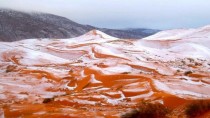
sahara-snowfall
Photo by Karim Bouchetata of Meteo Algerie
Amateur photographer Karim Bouchetata says he took the incredible pictures of snow covering the sand in the small Saharan desert town of Ain Sefra, Algeria, on December 19. The unforgiving red dunes looked pristine and picturesque.
“It looked amazing as the snow settled on the sand and made a great set of photos. The snow stayed for about a day and has now melted away.” he added.
Quote via The India Times
Paul Driessen
Having achieved major goals, US should refocus EPA and other environmental agencies
Donald Trump plans to “roll back progress” on climate change, energy and the environment, activists, regulators and their media allies assert. The claim depends on one’s definition of “progress.”
These interest groups define “progress” as ever-expanding laws, regulations, bureaucracies and power, to bring air and water emissions of every description down to zero, to prevent diseases that they attribute to manmade pollutants and forestall “dangerous manmade climate change.” Achieving those goals requires controlling nearly every facet of our economy, industries, lives, livelihoods and living standards.
If we are talking about halting and reversing this unbridled federal control, President-Elect Trump has promised to roll “progress” back - and not a moment too soon, if we are to rejuvenate our economy.
Federal land, resource and environmental agencies have unleashed tsunamis of regulations in recent years, and President Obama is poised to issue many more before January 20. The total cost of complying with federal rules was about $1 trillion annually in 2006. It has since doubled, raising the federal reporting and compliance burden to $6,000 per person per year, through late-2016.
The Obama Administration has thus far imposed some $743 billion of those new costs, via 4,432 new rules requiring 754 million hours of paperwork, according to a new American Action Forum analysis. The $2 trillion cumulative annual tab is more than all federal individual and corporate taxes collected in 2015; includes 10 billion hours dealing with paperwork; and does not include state or local regulations. Land use and environmental compliance costs account for a sizable and growing portion of this total.
These costs hogtie innovation, job creation and economic growth. They make millions unemployed.
So let us examine “progress” against two other standards: (1) pollution reductions to date; and (2) the validity of claims used to justify ever more burdensome and expensive environmental regulations.
We can never have zero pollution. The laws of diminishing returns increasingly come into play: getting rid of the last 10% can cost as much as eliminating the initial 90% and is rarely needed. And we cannot control nature’s pollution: volcanoes, forest fires, poisonous algae blooms, deep ocean vents, erosion of rocks bearing mercury and other toxic substances, and other sources.
However, we can reach the point where remaining pollutants pose few or no health risks - and we have largely done so. Since 1970, America’s cars have eliminated nearly 99% of pollutants that once came out of tailpipes, notes Air Quality in America co-author Joel Schwartz. Refiners have eliminated lead from gasoline and reduced its sulfur content by some 95% - while coal-fired power plants now remove 80-95% of the particulates, mercury, nitrogen oxides and sulfur dioxide that they emitted in 1970.
Asthma may be rising, but it’s certainly not because of pollution rates that have fallen dramatically.
Water quality has also skyrocketed. Along the river where I grew up in Wisconsin, a dozen pairs of bald eagles now nest where there were none when I was a kid, when you couldn’t eat the fish or swim in the polluted water. The same thing happened across the USA. Other problems remain to be addressed.
As President-Elect Trump has quipped,
“It used to be that cars were made in Flint, and you couldn’t drink the water in Mexico. Now our cars are made in Mexico, and you can’t drink the water in Flint.”
That’s because local officials and the USEPA didn’t do their jobs - didn’t monitor or fix failing, corroded lead water pipes. Repairing Flint’s system, and addressing water and sewer problems in other cities, will cost billions of dollars. If we are forced to spend tens or hundreds of billions on exaggerated, fabricated or imaginary risks, there will be little left to resolve our remaining real health problems.
Let us celebrate our progress, and turn our attention to real problems that still must be corrected. Let us also examine claims used to justify regulations - and roll back rules that don’t pass scientific muster.
EPA insists that saving fuel and reducing pollution from now super-clean vehicles requires that cars and light trucks get 54.5 mpg by 2025. But achieving this will force people to drive smaller, lighter, more plasticized, less safe cars - and millions more will be maimed and killed. EPA doesn’t mention that, or acknowledge that fracking ensures another century of oil and gasoline: time to devise new energy sources.
Above all, though, the Environmental Protection Agency’s reason for being, for wanting to steadily expand its budget and personnel, for seeking to regulate our farms, factories, homes and energy supplies, for trying to drive entire industries into bankruptcy - is its assertion that humans are causing catastrophic climate change, thereby endangering human health and welfare. The claims do not withstand scrutiny.
Even as atmospheric carbon dioxide levels continue to rise - spurring plant growth worldwide - except during the strong 2015/16 El Nino, average global temperatures have remained steady for 18 years. Polar and Greenland ice caps, sea levels, hurricanes, floods and droughts refuse to behave in accord with climate chaos claims, computer model predictions, or EPA and Obama White House assertions.
Meanwhile, as EPA moves to impose its “Clean Power Plan” and other draconian rules, developed and developing nations alike are building new coal-fired power plants every week, greatly expanding their oil and gas use, and reducing wind and solar subsidies. Even EPA analyses recognize that ending nearly all US fossil fuel use will prevent an undetectable global temperature rise of just 0.02 degrees by 2100.
So EPA has tried to justify its job and economy-killing climate change and coal eradication rules by claiming they will bring huge “ancillary” health benefits. Those claims too are pure hogwash.
US coal-fired power plants emit less than 0.5% of all the mercury that enters Earth’s atmosphere every year from Asian power plants, forest fires, volcanoes, subsea vents and geysers. EPA nonetheless claims its rules will magically bring benefits like an imperceptible 0.00209-point improvement in IQ scores!
The agency also says banning coal-fired power plants will reduce “carcinogenic” and “lethal” levels of microscopic particulate matter (soot) in America’s air. But EPA has no medical evidence that what is still in our air poses actual problems. In fact, EPA-funded researchers illegally subjected human test subjects - including elderly, asthmatic, diabetic and cardiac patients - to 8, 30 or even 60 times more soot per volume (for up to two hours) than what EPA claims is dangerous or lethal. And yet, no one got sick.
Obviously, EPA’s air quality standards and dire warnings about soot are totally out of whack with reality.
The federal government next concocted what it calls the “social cost of carbon” framework. It assigns a price to using carbon-based fuels and emitting carbon dioxide, by blaming US fossil fuels and CO2 for every imaginable and imaginary “harm” to wildlife, climate and humans worldwide. It completely ignores the enormous and undeniable benefits of using those fuels, the equally important benefits of plant-fertilizing CO2, and horrendous damage that would result from eliminating 81% of America’s energy.
Indeed, EPA and other regulators routinely ignore the impacts that their draconian regulations have on people’s jobs, living standards, health and welfare - including reduced or lost incomes, lower nutrition, welfare dependency, drug and alcohol abuse, and shorter life spans. They then present scientists, “health” and “environmental” organizations and advisory committees that approve and applaud the regulations anyway - often because the agencies pay them millions of dollars a year to do so.
That’s how bureaucrats remain powerful, unaccountable and immune from being fired or having to compensate victims for their incompetent or even deliberate falsifications and actions. We end up being protected from exaggerated and fabricated risks, years or decades from now - by having jobs, companies, industries, families, communities, and our overall health and welfare hammered by over-regulation today.
America’s voters rejected this agenda. Over 90% of the nation’s counties voted to Trump the bridge hand to tyranny. We do not want to roll back true environmental progress. But we do demand a return to sanity, science, and honest consideration of our overall health, welfare and “human environment” in approving regulations that govern our lives. Let’s insist that the new Congress and Administration do exactly that.
Paul Driessen is senior policy analyst for the Committee For A Constructive Tomorrow (www.CFACT.org), and author of Eco-Imperialism: Green power - Black death and other books on the environment.



